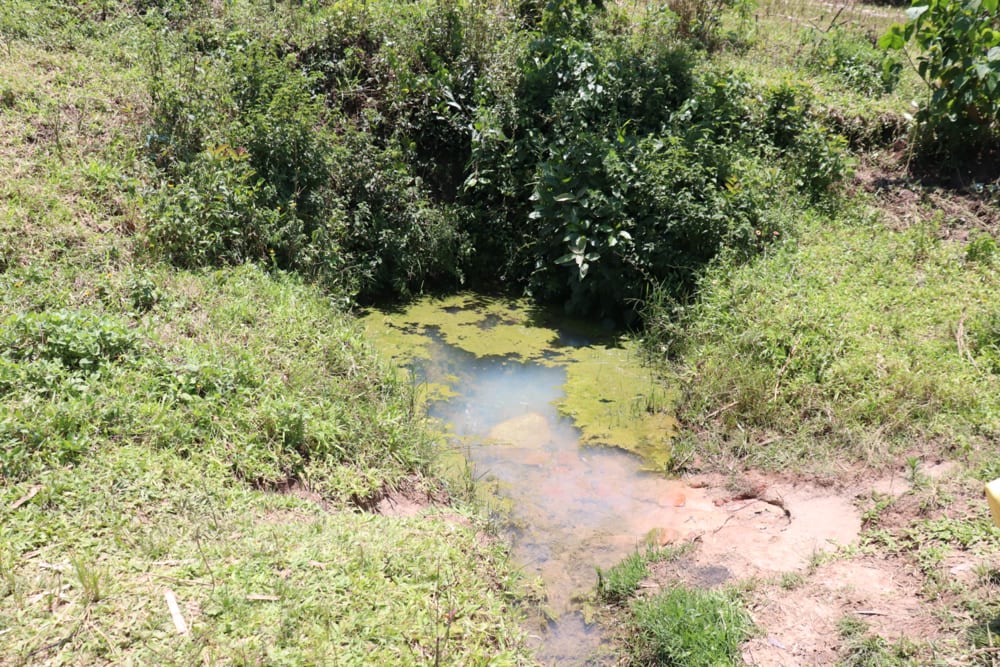The Elwichi Community is situated in a quiet part of Malava. Walking into the community, one already feels the calm and the sudden change in the way people interact. Elwichi community members are calm and quiet. From the way they talk to how they handle their businesses, they do not seem to be in haste as their neighbors do.
Here, birds, animals, trees, children, and a few elders conversing are the only sounds you will hear. Most of the houses here are mud-walled with iron sheets as roofs. Community members have also coated their walls with cow dung for beautification. Here, farmers make up most of the community, with a few people working as casual laborers. A few others own small businesses selling their farm produce and other products.
220 community members in Elwichi fetch their water from Mulunda Spring, but the spring falls short of being a safe water point in several ways. First, the waterpoint is open and is always covered in leaves and grass. Second, moss and algae are growing inside and on the water's surface, forming a green carpet-like layer. Third, small animals like toads call the water home, in addition to insects, mosquitoes, and bacteria that harbor dangerous diseases, including malaria. However, it is easy to access and does not dry up; the water itself is a health hazard.

For people to use the spring water for drinking, they use the solar disinfection method to treat it. But this treatment requires several hours of direct sun and someone to stand guard to be sure no animal or person contaminates it in the process. Nonetheless, the water is almost always contaminated. A community member - usually a child - has to keep watch over the water to keep away animals and birds from dipping in it. If a child is not present, an older adult has to stand guard. The containers that hold the water are full of their own dirt and algae, and the method proves to be very ineffective as people still get sick.
3 community members whom we spoke to at the spring, Dora, Ruth, and Henry, all complained of having stomach upsets and severe diarrhea and vomiting whenever they drank water directly from the waterpoint. They said the doctor confirmed their cases related to typhoid, dysentery, and malaria, all likely originating because of the spring water.
"This water is good. It is good because it is there throughout the year. But it is risky water. One time I was diagnosed with typhoid, and my children had to take care of me for close to a week, forcing them out of school. This water has also cost me a cow almost every year, and especially during the dry season because we rely on it for everything," said Dora Musochi, a 37-year-old farmer, businessperson, and mother in Elwichi.
These same illnesses among the families who use this spring have led to a loss of family finances due to their medical bills and livestock loss, as Dora mentioned. Time spent at home or in the hospital while sick also disrupts routines, leading to fewer productive hours and less income earned among adults. On the other hand, children have to stay home from school and often end up falling behind in their lessons.
"My mom fell ill of a stomach upset, and we had to stay home to take care of her for a week. Our teachers scolded us when we returned to school," recalled young primary school-aged Blessing, Dora's daughter.
What We Can Do:
Spring Protection
Protecting the spring will help provide access to cleaner and safer water and reduce the time people have to spend to fetch it. Construction will keep surface runoff and other contaminants out of the water. With the community’s high involvement in the process, there should be a good sense of responsibility and ownership for the new clean water source.
Fetching water is a task predominantly carried out by women and young girls. Therefore, protecting the spring and offering training and support will help empower the female members of the community by freeing up more of their time and energy to engage and invest in income-generating activities and their education.
Training on Health, Hygiene, COVID-19, and More
To hold training during the pandemic, we work closely with both community leaders and the local government to approve small groups to attend training. We ask community leaders to invite a select yet representative group of people to attend training, which will then act as ambassadors to the rest of the community to share what they learn. We also communicate our expectations of physical distancing and wearing masks for all who choose to attend.
The training will focus on improved hygiene, health, and sanitation habits in this community. We will also have a dedicated session on COVID-19 symptoms, transmission routes, and prevention best practices.
With the community’s input, we will identify key leverage points to alter their practices at the personal, household, and community levels to affect change. This training will help to ensure participants have the knowledge they need about healthy practices and their importance to make the most of their water point as soon as the water is flowing.
Our team of facilitators will use a variety of methods to train community members. Some of these methods include participatory hygiene and sanitation transformation, asset-based community development, group discussions, handouts, and demonstrations at the spring.
One of the most important issues we plan to cover is handling, storing, and treating water. Having a clean water source will be extremely helpful, but it is useless if water gets contaminated by the time it is consumed. The community and we strongly believe that all of these components will work together to improve living standards here, which will help to unlock the potential for these community members to live better, healthier lives.
We will then conduct a small series of follow-up training before transitioning to our regularly scheduled support visits throughout the year.
Training will result in the formation of a water user committee, elected by their peers, that will oversee the spring's operations and maintenance. The committee will enforce proper behavior around the spring and delegate tasks that will help preserve the site, such as building a fence and digging proper drainage channels. The fence will keep out destructive animals and unwanted waste, and the drainage will keep the area’s mosquito population at a minimum.

 Protected Spring
Protected Spring
 Rehabilitation Project
Rehabilitation Project













































